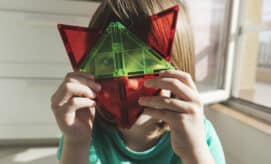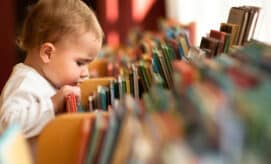How do we know that a child is ready for kindergarten? As early care and education providers, we support the physical, social, emotional and cognitive skill development that sets the stage for children to thrive in kindergarten, elementary school and beyond. In this article, we take a look at math and numeracy awareness, with a focus on early math learning experiences that are foundational to a child’s later academic success. This is the second article in G2K’s Kindergarten Readiness Series, which explores the learning domains of early childhood.
What are Early Math & Numeracy Skills?
Early math and numeracy skills include a foundational understanding of numbers, shapes, spacing, and measurement. Awareness of these concepts begins during infancy and continues to develop throughout early childhood, as little ones begin to understand how the items in their environment relate to one another. Early math and numeracy skills help children to understand the world around them, and to quantify, compare, and categorize all that they are discovering. This opens new ways of observing and thinking, all of which have a positive impact on academic learning.
Critical Numeracy Skills
An article about early math skills from ZERO TO THREE, lists the foundational numeracy concepts that equip young children to learn more advanced math concepts in elementary school and beyond. These early math building blocks include:
- Number sense (counting and recognizing relationships between numbers)
- Representation (understanding that mathematical words, pictures, and symbols correspond to specific objects)
- Spatial sense (ideas of shape, size, space, position, direction and movement)
- Measurement (length, height, and weight of an object using units)
- Estimation (guessing and comparing sizes of objects)
- Patterns (identifying examples of numbers, shapes, and images that repeat in a logical way)
- Problem-solving (thinking through a problem and its potential solutions).
How do Math Skills Impact Elementary School Success?
A foundational understanding of mathematics and numeracy plays an important role in kindergarten readiness by establishing a strong footing for more complex learning as children get older. According to a joint statement from the National Association for the Education of Young Children (NAEYC) and the National Council of Teachers of Mathematics (NCTM):
“Mathematics helps children make sense of their world outside of school and helps them construct a solid foundation for success in school. In elementary and middle school, children need mathematical understanding and skills not only in math courses but also in science, social studies, and other subjects. In high school, students need mathematical proficiency to succeed in course work that provides a gateway to technological literacy and higher education. Once out of school, all adults need a broad range of basic mathematical understanding to make informed decisions in their jobs, households, communities, and civic lives.”
There is also evidence that early mathematical skill-building has a positive impact in children’s lives beyond academics. An article by Linda M. Platas, an early childhood researcher and chair of the Child and Adolescent Development Department at San Francisco State University, explains that in early learning classrooms, the activities that involve meaningful math exploration also promote children’s SEL skills. When children play together with blocks, for example, they are learning key geometrical concepts while also practicing communication, collaboration, and sharing. Many cooperative games, such as hopscotch, encourage children to practice counting and number recognition, while also taking-turns, and practicing self-regulation.
How do Math & Numeracy Skills Develop in the First 5 Years?
Young children begin to explore and develop math concepts from infancy! Little ones are exposed to mathematical ideas and relationships during everyday experiences and interactions with their caregivers. Below, you’ll find developmental math milestones, as organized by Reach Out and Read, along with information and ideas educators can use to support awareness of foundational math concepts among young children at each developmental stage.
- 6 months–2 years: Infants and young toddlers are beginning to follow along with their caregivers as they count and use comparison words such as “big,” “little,” and “tall.” Educators can support children at this age in their development by singing songs, reading books, and playing games that involve numbers and word repetition.
- 2-3 years: Preschoolers are beginning to recite numbers (although not always in order) and they enjoy pretending to count while pointing at items. As educators, we can model counting by touching an object as we say its number. For example, “How many cheerios are on your plate? Here’s one, two, three…”
- 3–4 years: Preschoolers are able to recite numbers in sequence up to 5 or 10 and compare items by looking at their height, length, and size. Educators can support children at this age by comparing quantities during everyday conversations. For example, “Hmm, you and I both have blueberries in front of us…I wonder who has more. Let’s count and see!” or “This box has two blocks in it, and that box has one.”
- 4-5 years: As children approach kindergarten, they begin to measure with informal measurement tools, such as their hands or blocks, and they are able to recognize written numbers. At this age, we can help children continue to grow their skills by encouraging them to describe and compare the items and patterns they see.
Incorporating Math into your Early Childhood Curriculum
Educators can support foundational mathematical skill development by using math words during daily routines and activities, like talking, singing, playing, and reading books together.
Music & Songs
The music and songs that young children enjoy incorporate rhythm and repetition, as well as lyrics that often include counting and comparison. An article from DREME offers suggestions for exploring math and music with the little ones in your care: “Children’s songs often rely on patterns and repetition—both of which are part of math. Some songs involve counting (e.g.,The Ants Go Marching One by One). Other songs include concepts like up and down (e.g., The Wheels on the Bus) and you can include hand motions to highlight these ideas for your child. You can also use your fingers to show the numbers you are singing about or find objects around the house to count as you sing along.”
Storytime
Reading books together is a simple and engaging way to introduce math language and concepts to young children. Early care & learning providers can highlight counting, shapes, and size comparisons as they read books to the children during storytime. To find math-themed books for your classroom, check out the following G2K articles from the archives: Geometric Shape Books for Infants & Toddlers and Math-themed Children’s Books & Learning Activities for Preschool & Pre-k.
Even when books aren’t math-themed, early learning providers can incorporate math concepts into stories by asking the children to notice numbers, sizes and patterns. For example, you might count the number of clouds in the sky or flowers in the grass in a book’s illustrations.
Snacktime
Snacktime is a great opportunity to explore counting, shapes, and sizes with the children in your care! You might point out some of the shapes in their food, such as the circular shape of an apple, the square shape of a slice of cheese, or the oval shape of grapes. You might also count as you hand out snacks, by saying something like, “We’re all going to get four crackers today. Can you help me count? One, two, three, four! Let’s do it again!”
Find more inspiration in this G2K article from the archives: 5 Ideas for Exploring Shapes with Young Children During Snack Time.
Transitions, Play, & Daily Routines
Early learning classrooms and daily routines such as morning meetings, playtime, clean-up, and lining up, are filled with opportunities to explore foundational math skills. For example, when children are cleaning up toys, they are also sorting items by category into different baskets. As children build with blocks, they use words like “bigger,” and “taller,” to describe the structures they are creating. When numbers are part of everyday experiences, children see math as both useful and relevant in their daily lives.
We can expand on children’s awareness of math concepts by using words and making observations related to shapes, patterns, and numbers throughout the day. We can point out the different shapes of blocks children are using, help them measure how tall their tower is, and count toys as they put them away. For more ideas about incorporating math in your classroom’s daily routines, you might enjoy the following resources: Making Math a Part of Everyday Preschool Routines, a G2K article from the archives, and Math Moments, ideas for building math into routine classroom activities from DREME.
Additional Math Tips and Resources from G2K
If you’d like to find more resources and information about how to support children as they build foundational math skills, you might enjoy these G2K articles from the archives:





